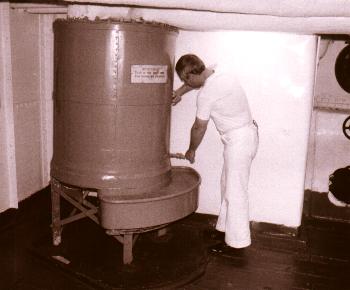
The Crew Space
Part II
By Patrick McSherry
As the visitor continues along the crew area on the Berth
Deck, looking overhead, the visitor will see a series of hooks. These hooks
were used by the crew to support their hammocks. Each crewman was assigned
a numbered set of hooks, and only alternating hooks were used. This allowed
each man a space of approximately 32 inches by 96 inches for his
hammock to swing. From this close spacing, it can clearly be seen that
the crew accommodations were quite crowded. Also, in the overhead area
can be seen the galley tables, which are stored on supports in an inverted
position from the deck above. The mess tables present seem to be from the
1902 refit of OLYMPIA, since they have legs.
The original tables used in 1898 were supported by lines from the overhead.
OLYMPIA was the only ship in the Asiatic squadron that retained her tables
after the Battle of Manila Bay. The commanders of
the other vessels in squadron jettisoned their wood tables, benches, etc.
for fear of splinters and fire that could result in battle. On the flagship,
there was apparently such confidence that there was no order given to throw
the tables overboard. As a result, for several months after the battle,
the crew of the OLYMPIA was the only crew in the Asiatic Squadron that
did not have to eat their meals off the deck. If so, their presence today
is evidence of Commodore Dewey’s decision not to
jettison wooden equipment before the Battle of Manila Bay.

In this original view of the crew on OLYMPIA,
note the tables slung from the overhead, the white enameled tinwear
which had a blue stripe around the rim, and the hats hanging on the hammock
hooks, above. The men appear to be having a hearty meal of a stew with
potatoes, an egg, an apple and a slice of bread. This would indicate that
this mess has a good caterer (the man designated to purchase supplies for
this mess of about 24 men).
This area of the vessel also houses the “scuttlebutt”
or water dispenser. The term “scuttlebutt,” came into being because
of the exchange of news, real or imagined, that occurred when the men met
at the "scuttlebutt." The "scuttlebutt", is approximately 32 inches in
diameter and five feet, six inches high. The water in the “scuttlebutt”
was cooled by the vessel’s innovative refrigeration system.

A member of the Living History Crew gets water at
the "scuttlebutt"




